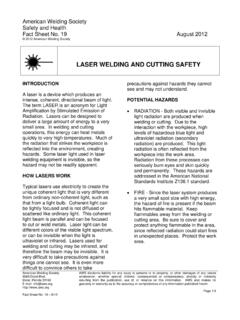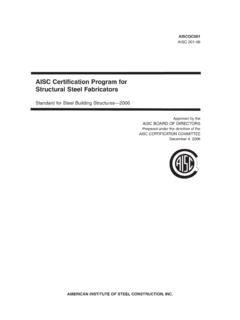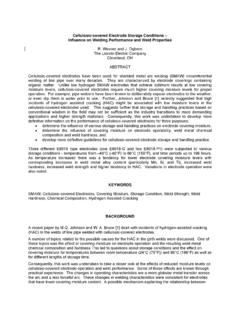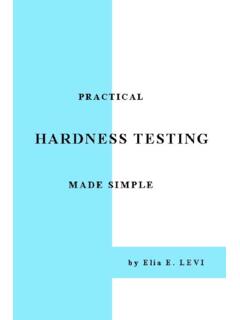Transcription of 2. Design of Welded Connections - American Welding Society
1 AWS ScopeThis section covers the requirements for the Design ofwelded Connections . It is divided into four Parts, de-scribed as follows:Part A Common Requirements of Nontubular andTubular Connections . This part covers the requirementsapplicable to all Connections , regardless of the productform or the type of loading, and shall be used with theapplicable requirements of Parts B, C, and B Specific Requirements for Nontubular Con-nections (Statically or Cyclically Loaded). This part cov-ers the specific requirements for Connections betweennon-tubular cross-sections, regardless of the type ofloading, and shall be used with the applicable require-ments of Parts A and C Specific Requirements for Cyclically LoadedNontubular Connections . This part covers the specific re-quirements for Connections between nontubular cross-sections subjected to cyclic loads of sufficient magnitudeand frequency to cause the potential for fatigue failure,and shall be used with the applicable requirements ofParts A and D Specific Requirements for Tubular Connec-tions.
2 This part covers the specific requirements for con-nections between tubular cross-sections, regardless ofthe type of loading, and shall be used with the applicablerequirements of Part ACommon Requirements ofNontubular and Tubular Allowable Base- metal Stresses. The base-metalstresses shall not exceed those specified in the applicabledesign Allowable Increase. Where the applicable designspecifications permit the use of increased stresses in thebase metal for any reason, a corresponding increase shallbe applied to the allowable stresses given herein, but notto the stress ranges permitted for base metal or weldmetal subject to cyclic Laminations and Lamellar Tearing. Wherewelded joints introduce through-thickness stresses, theanisotropy of the material and the possibility of base- metal separation should be recognized during bothdesign and fabrication (see Commentary).
3 Drawing Information. Full and complete informa-tion regarding location, type, size, and extent of all weldsshall be clearly shown on the drawings. The drawingsshall clearly distinguish between shop and field Joint Welding Sequence. Drawings of thosejoints or groups of joints in which it is especially impor-tant that the Welding sequence and technique be carefullycontrolled to minimize shrinkage stresses and distortionshall be so Weld Size and Length. Contract Design drawingsshall specify the effective weld length and, for partialpenetration groove welds, the required weld size, as de-fined in this code. Shop or working drawings shall spec-ify the groove depths (S) applicable for the weld size (E)required for the Welding process and position of weldingto be Groove Welds. Detail drawings shall clearly indi-cate by Welding symbols or sketches the details ofgroove Welded joints and the preparation of material re-quired to make them.
4 Both width and thickness of steelbacking shall be Symbols. It is recommended that contract de-sign drawings show complete joint penetration or partialjoint penetration groove weld requirements without spec-ifying the groove weld dimensions. The Welding symbol2. Design of Welded ConnectionsAWS :2000 Design OF Welded CONNECTIONS4without dimensions designates a complete joint penetra-tion weld as follows:The Welding symbol with dimensions above or below thereference line designates a partial joint penetration weld, Prequalified Detail Dimensions. The jointdetails specified in (PJP) and (CJP) have re-peatedly demonstrated their adequacy in providing theconditions and clearances necessary for depositing andfusing sound weld metal to base metal . However, the useof these details in prequalified WPSs shall not be inter-preted as implying consideration of the effects of weld-ing process on material beyond the fusion boundary norsuitability for a given Special Details.
5 When special groove detailsare required, they shall be completely detailed in the con-tract Special Inspection Requirements. Any specialinspection requirements shall be noted on the drawingsor in the Groove Effective Weld Length. The maximum effectiveweld length for any groove weld, square or skewed, shall bethe width of the part joined, perpendicular to the directionof tensile or compressive stress. For groove welds transmit-ting shear, the effective length is the length Effective Area. The effective area shall be the ef-fective weld length multiplied by the weld Partial Joint Penetration Groove Minimum Weld Size. Partial joint penetra-tion groove weld sizes shall be equal to or greater thanthe size specified in unless the WPS is qualifiedper section Effective Weld Size (Flare Groove).
6 The ef-fective weld size for flare groove welds when filled flushto the surface of a round bar, a 90 bend in a formed sec-tion, or a rectangular tube shall be as shown in Table ,except as permitted by Complete Joint Penetration Groove Weld Size. The weld size of a complete jointpenetration groove weld shall be the thickness of thethinner part joined. No increase in the effective area fordesign calculations is permitted for weld weld sizes for welds in T-, Y-, and K-connectionsin tubular members are shown in Table Fillet Effective Calculation. The effective throat shall be theshortest distance from the joint root to the weld face ofthe diagrammatic weld (see Annex I). Note: See Annex IIfor formula governing the calculation of effective throatsfor fillet welds in skewed T-joints.
7 A tabulation of mea-sured legs (W) and acceptable root openings (R) relatedto effective throats (E) has been provided for dihedralangles between 60 and 135 . Shear Stress. Stress on the effective throat offillet welds is considered as shear stress regardless of thedirection of the Reinforcing Fillet Welds. The effectivethroat of a combination partial joint penetration grooveweld and a fillet weld shall be the shortest distance fromthe joint root to the weld face of the diagrammatic weldminus 1/8 in. (3 mm) for any groove detail requiringsuch deduction (see Figure and Annex I). Effective Length (Straight). The effectivelength of a straight fillet weld shall be the overall lengthof the full-size fillet, including boxing. No reduction ineffective length shall be assumed in Design calculationsto allow for the start or stop crater of the Effective Length (Curved).
8 The effectivelength of a curved fillet weld shall be measured along thecenterline of the effective throat. If the weld area of a fil-let weld in a hole or slot calculated from this length isgreater than the area calculated from , then this latterarea shall be used as the effective area of the fillet Weld Sizes of Flare Groove Welds (see )Flare-Bevel-Groove WeldsFlare-V-Groove Welds5/16 R1/2 R*Note: R = radius of outside surface*Use 3/8 R for GMAW (except short circuiting transfer) process whenR is 1/2 in. (12 mm) or OF Welded CONNECTIONSAWS Minimum Length. The minimum effectivelength of a fillet weld shall be at least four times thenominal size, or the effective size of the weld shall beconsidered not to exceed 25% of its effective Effective Area. The effective area shall be the ef-fective weld length multiplied by the effective in a fillet weld shall be considered as applied tothis effective area, for any direction of applied Minimum Leg Size.
9 See for the minimumleg sizes required for fillet Maximum Fillet Weld Size. The maximum filletweld size detailed along edges of material shall be thefollowing:(1) the thickness of the base metal , for metal less than1/4 in. (6 mm) thick (see Figure , Detail A)(2) 1/16 in. (2 mm) less than the thickness of basemetal, for metal 1/4 in. (6 mm) or more in thickness (seeFigure , Detail B), unless the weld is designated onthe drawing to be built out to obtain full throat the as- Welded condition, the distance between theedge of the base metal and the toe of the weld may beless than 1/16 in. (2 mm), provided the weld size isclearly Intermittent Fillet Welds (Minimum Length).The minimum length of an intermittent fillet weld shallbe 1-1/2 in. (40 mm). Fillet Weld Drawings.
10 The length and disposition ofwelds, including end returns or boxing, shall be indicatedon the Design and detail drawings. Fillet weld termina-tions may extend to the ends or sides of parts or may bestopped short or may be boxed except as limited through Lap Joints. In lap joints between parts subjectto calculated tensile stress in which one part extends be-yond the edge or side of the part to which it is connected,Figure Details for Prequalified Fillet Welds (see )fillet welds shall terminate not less than the size of theweld from the start of the extension (see Commentary). Maximum End Return Length. Flexibleconnections rely on the flexibility of the outstanding the outstanding legs are attached with end returnedwelds, the length of the end return shall not exceed fourtimes the nominal weld size.










